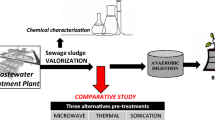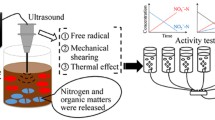Abstract
The aim of this study was to justify the method to determine biochemical methane potential (BMP) of biosludges and investigate the effect of ozonation and sonication on the biosludge from textile mill effluent to its biodegradability and toxicity. This study revealed that the exented anaerobic toxicity assay at a chemical oxygen demand (COD) concentration in the assay of about 1,500 mg/L was the appropiate technique to determine BMP of the biosludge. Moreover, it was found that the biodegradability of biosludge was satisfactorily increased by both of ozonation and sonication. The use of ozone dose of 0.005 g O3/g COD and 0.01 O3/g COD increased the biodegradability from 62% to 69% and 76%, respectively. While for sonication on frequency 51 kHz ±6%, 120 W for 30 and 60 min increased the biodegradability from 62% to 68% and 73%, respectively.

Similar content being viewed by others
References
American Public Health Association (APHA). (1965). Standard methods for the examination of water and wastewater, 12th edition. Water Pollution Control Federation, Washington, DC: American Water Works Association.
American Public Health Association (APHA). (1992). Standard methods for the examination of water and wastewater. In L. S. Clesceri, A. E. Greenberg & R. R. Trussel (Eds.), American Water Works Association (18th ed.). Washington, DC: Water Pollution Control Federation.
Bougrier, C., Albasi, C., Delgenes, J. P., & Carrere, H. (2006). Effect of ultrasonic, thermal and ozone pre-treatment on waste activated sludge solubiliston and anaerobic biodegradability. Chemical Engineering and Processing, 45, 711–718.
Bougrier, C., Carrere, H., & Delgenes, J. P. (2005). Solubilisation of waste activated sludge by ultrasonic treatment. The Chemical Engineering Journal, 106(2), 163–169.
Cesbron, D., Deleris, S., Debellefontaine, H., Roustan, M., & Paul, E. (2003). Study of competition for ozone between soluble and particulate matter during activated sludge ozonation. Chemical Engineering Research and Design, 81(Part A), 1165–1170.
Chen, S. J., Li, C. T., & Shieh, W. K. (1985). Performance evaluation of the anaerobic fluidized bed system: I Substrate utilization and gas production. Journal of Chemical Technology and Biotechnology, 35B, 101–109.
Dohanyos, M., Zabranska, J., Jenicek, P., Stepova, J., Kutil, V., & Horejs, J. (2000). The intensification of sludge digestion by the disintegration of activated sludge and the thermal conditioning of digested sludge. Water Science Technology, 12(9), 57–64.
Goel, R., Tokutomi, T., & Yasui, H. (2003). Anaerobic digestion of excess activated sludge with ozone pretreatment. Water Science and Technology, 47(12), 207–214.
Grady, C. P. L., & Lim, H. C. (1980). Biological wastewater treatment (Theory And Application). New York: Marcel Dekker Inc.
Heredia, J. B., & Garcia, J. (2005). Kinetics, catalyst and reaction engineering, process integration: continous anaerobic digestion-ozonation treatment of Olive Mill Waste. Industrial and Engineering Chemistry Research, 44, 8750–8755.
Juanga, J. P. (2005). Optimizing dry anaerobic digestion of organic fraction of municipal solid waste, version in: Master thesis. Thailand: Asian Institute of Technology.
Kroiss, H. (2004). What is the potential for utilizing the resources in sludge? Water Science and Technology, 49(10), 1–10.
Lissens, G., Thomsen, A. B., De Baere, L., & Verstraete, W. (2004). Thermal wet oxidation improves anaerobic biodegradability of raw and digested biowaste. Journal of Environmental Sciences, 38, 3418–3424.
Neis, U., Nickel, K., & Tiehm, A. (2000). Enhancement of anaerobic sludge digestion by ultrasonic disintegration. Water Science and Technology, 42(9), 73–80.
Owen, W. F., Stuckey, D. C., Healy, J. B., Young, L. Y., Jr., & McCarty, P. L. (1979). Bioassay for monitoring biochemical methane potential and anaerobic toxicity. Journal of Water Resources, 13, 485–492.
Scheminski, A., Krull, R., & Hempel, D. C. (2000). Oxidative treatment of digested sewage sludge with ozone. Water Science and Technology, 49(9), 151–158.
Speece, R. E., Parkin, G. G., Takashima, M., & Bhattacharya, S. (1986). Trace nutrient requirements of anaerobic digestion. Drexel University, USA. Water Treatment Conference, Aquatech.
Tiehm, A., Nickel, K., Zellhorn, M., & Neis, U. (2001). Ultrasonic waste activated sludge disintegration for improving anaerobic stabilization. Water Research, 35(8), 2003–2009.
Author information
Authors and Affiliations
Corresponding author
Rights and permissions
About this article
Cite this article
Desiana, D., Setiadi, T. Effect of Ozonation and Sonication on Biochemical Methane Potential of Biosludge from Textile Mill Effluent. Water Air Soil Pollut: Focus 9, 461–467 (2009). https://doi.org/10.1007/s11267-009-9239-5
Received:
Accepted:
Published:
Issue Date:
DOI: https://doi.org/10.1007/s11267-009-9239-5




